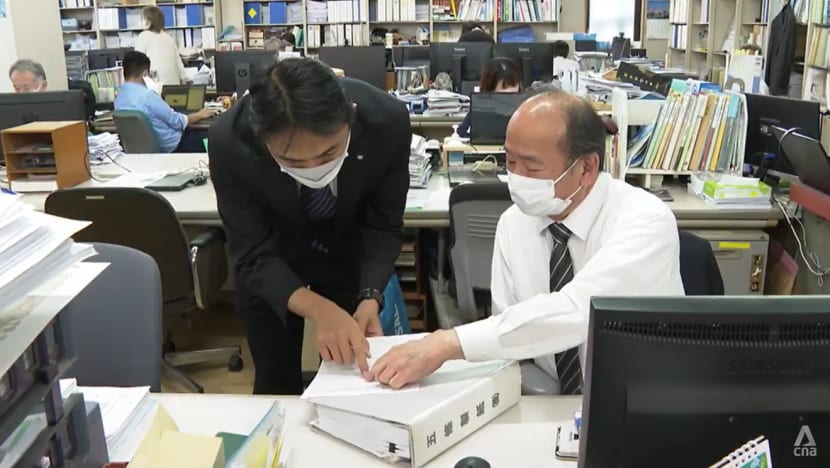Migrant workers in Japan: Firms turn to foreigners to ease labour shortage
There were more than 2.8 million foreigners in Japan as of June 2021, double that in the 1990s.

More Japanese firms are starting to look like the inside of Kyoritsu Electric's office in Shizuoka. The firm hires foreigners, among them Indonesians.
TOKYO: More Japanese firms are starting to look like the inside of Kyoritsu Electric's office in Shizuoka - with the presence of foreigners among its employees.
Hit by manpower woes, the company has turned to foreign employees to plug staffing gaps in a country that's largely ethnically homogenous.
These employees support the company’s expansion beyond its eight existing overseas branches.
However, having foreign workers is not just about easing labour shortages, said the firm’s president Nobuyuki Nishi.
It is a part of his strategy to create an international environment to expose his Japanese employees to different customs and cultures, as he expects to sell to more customers overseas.
“Some countries have Muslims, there are many countries with a diverse population. It’s about respecting everyone’s culture,” he told CNA.
“Another point is, the word ‘diversity’ is often used. We need the Japanese to adapt to this. We need foreigners for that. Also, if we work together, we will learn about their cultures, ways of thinking and values. It can inspire all of us.”
Once known for its homogeneity, Japan is now opening its doors to welcome more migrant workers, in order to sustain its economic growth.
There were more than 2.8 million foreigners in Japan as of June last year, a figure double that in the 1990s.
The size of the foreign labour force in Japan has also risen three-fold in the past decade.
WANTING TO WORK IN JAPAN
Among Mr Nishi’s employees is 31-year-old Kadek Yud Prasadha from the Indonesian island of Sumatra.
He first came to Japan as a technical trainee in 2012 and spent three years with a manufacturer of automotive spare parts in Ishikawa Prefecture.
He returned to his country to work in the IT industry, but decided he wanted to return to Japan, this time not as a trainee.
In December 2021, he was hired by Kyoritsu Electric and handles projects at the firm that provides factory automation solutions to its clients.
He said he returned as he wanted to “learn how to work as an employee in Japan”.
Mr Prasadha now has his own space, a small apartment provided by the company, unlike back when he was a technical trainee and had to share rooms. He has long-term plans for his stay in the country.
“I really want to have something in Japan, not only work, but I also want to have family here,” he said.
TECHNICAL TRAINEE PROGRAMME
Most Indonesians like Mr Prasadha come to Japan through the country’s technical trainee programme that was introduced in 1993.
Vietnamese nationals are also known to come to Japan via the programme. Among them is Nguyen Ha Trong, whose job scope involves plastering walls. He is one of nine trainees hired at Corona Kogyo.
Company president Keiji Takei said he wanted to secure young skilled workers, as the firm’s skilled workers are aging. After turning to Japanese high schools and looking for experienced workers, he was advised to hire Vietnamese workers, he said.
“I have welcomed young Vietnamese workers to work for us full-time. It's a big asset for us to be able to hire from overseas young people who can work onsite,” he said.
Vietnamese made up 26 per cent of Japan’s 1.7 million foreign workers as of October 2021. Most of them came to Japan under the technical intern training programme.
Technical trainees typically pay a fee to agents back home for their internships.
For the Vietnamese, the fee goes up to 1 million yen (US$7,400), which leaves some in debt even before they arrive in the country. For Indonesians, the average fee is lower at about US$2,000.
CRITICISM FOR PROGRAMME
While Mr Takei said his trainees are treated the same as other employees, the treatment of such migrant workers has come under the spotlight recently.
Videos of a Vietnamese technical trainee in the western city of Okayama being abused sparked outrage. He was allegedly bullied by his Japanese co-workers for his poor command of the local language, although trainees are not required to be fluent in Japanese.
The programme started as a way for firms to bring in interns from developing countries, mostly from Southeast Asia, who would learn new skills and then impart them to fellow countrymen back home.
It has however been criticised as a way for firms to access cheap sources of manual labour for farms, factories and other businesses in Japan. Human rights groups have accused the Japanese government of turning a blind eye to this.
Associate Professor of Organisation for International Collaboration at Shizuoka University Yoichi Hiruma said: "We hear of those running away, gone missing.”
He added however that the problem is believed to be happening in sectors other than the nursing care sector.
MANPOWER FOR ELDERLY CARE
The elderly care industry in Japan, which suffers from a severe shortage of workers, has increasingly looked overseas to ease the labour crunch.
The segment of Japanese aged 65 and above currently stands at just over 36 million, accounting for 28.9 per cent of the total population.
According to the Health, Labour and Welfare Ministry, there are more than 15,000 private elderly care homes in the country and the number continues to grow.
In 2020, the industry lacked 130,000 care workers. If this trend continues, the gap will grow to 320,000 by 2025.
One foreigner in the sector is Vietnamese Nguyen Thi Yen Nhi, who arrived in Japan in April to work after a two-year delay due to the COVID-19 pandemic.
She is one of eight Vietnamese nationals hired under the country's technical trainee programme by Sompo Care, one of Japan’s largest elderly care companies with 23,000 employees.
Assigned to a nursing home in Yokohoma after her training, Ms Nhi has been performing basic tasks such as serving drinks to senior residents to keep them hydrated. She also keeps an eye on the elderly who are immobile.

However, the home can only hire them as technical trainees, as they are not certified caregivers. To get certified, Ms Nhi must pass the national examination.
And to prepare for that she and other colleagues attend training courses provided by the company when she is off duty.
RETAINING EMPLOYEES
While firms are becoming more open to hiring migrant workers, they are also keen to retain them, which may be difficult as they may not share the Japanese culture of lifetime employment.
This is something Mr Masaaki Maebashi, who runs an IT company in Mishima, found out first-hand, after a Vietnamese employee who worked for him left after two years.
"His Japanese, his skills improved exceptionally. But he moved on to Rakuten. He left for a major firm," he said.
Half the employees at the IT firm are from countries like India, Vietnam and China.
Instead of lamenting the situation, however, Mr Maebashi started a new system to deal with it.
With plans for some of his foreign staff members to relocate and continue working for him as he expands his business to the more rural parts of Japan, Mr Maebashi initiated a new policy to retain his employees.
"It’s to accumulate retirement funds. The more time with us, the bigger the reserves," he said.
"I want them to work here for 10, 20 years."

















